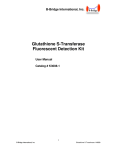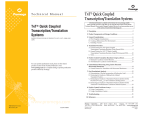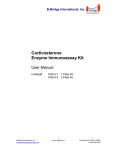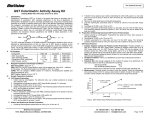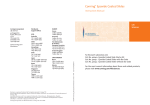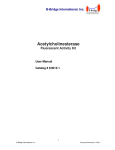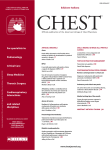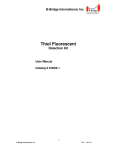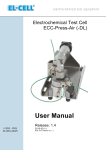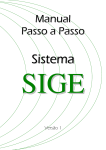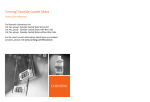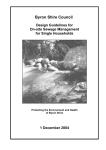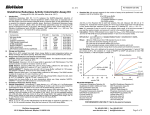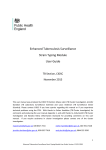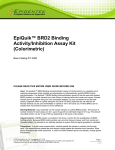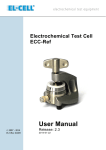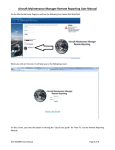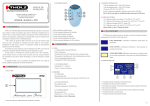Download Glutathione Colorimetric Detection Kit - B
Transcript
B-Bridge International, Inc. Glutathione Colorimetric Detection Kit User Manual Catalog # K3006-C 1 B-Bridge International, Inc. Glutathione 110628 TABLE OF CONTENTS Intended Use 3 Background 3 Assay Principle 3 Kit Components 4 Materials Required 4 Precautions 4 Reagent Preparation 5 Sample Preparation 6 Assay Protocol- End Point 7 Assay Protocol- Kinetic 7 Calculations 8 Typical Standard Curve: Example 8 Notice to Purchaser This product is to be used for Research Purposes Only. It is not to be used for Drug or Diagnostic Purposes, nor is it intended for Human Use. B-Bridge products may not be resold, modified for resale, or used to manufacture commercial products without the express written consent of B-Bridge International, Inc. EXCEPT AS OTHERWISE EXPRESSLY SET FORTH IN THIS USER MANUAL, B-BRIDGE DOES NOT MAKE ANY REPRESENTATION OR WARRANTIES OR CONDITIONS OF ANY KIND, EITHER EXPRESSED OR IMPLIED, WITH RESPECT TO THE PRODUCTS, OR INFORMATION DISCLOSED HEREUNDER, INCLUDING, BUT NOT LIMITED TO, THE IMPLIED WARRANTIES OF MERCHANTABILITY, FIT FOR A PARTICULAR PURPOSE, OR NONINFRINGEMENT OF THE INTELLECTUAL PROPERTY RIGHTS OF THIRD PARTIES. B-Bridge International, Inc. All Rights Reserved. 2 B-Bridge International, Inc. Glutathione 110628 INTENDED USE The B-Bridge Glutathione Colorimetric Detection Kit (cat.# K3006-C) quantitatively measures Glutathione (GSH) and oxidized glutathione (GSSG) in Human Whole Blood, Serum, Plasma, Erythrocytes, Urine, Cell Lysates and Tissue Samples. GSH is identical across species and we expect this kit may measure GSH from sources other than human. BACKGROUND Glutathione (L-γ-glutamyl-L-cysteinylglycine; GSH) is the highest concentration non-protein thiol in mammalian cells and is present in concentrations of 0.5 – 10 mM. GSH plays a key role in many biological processes, including the synthesis of proteins and DNA, the transport of amino acids, and the protection of cells against oxidation. Harmful hydrogen peroxide cellular levels are minimized by the enzyme glutathione peroxidase (GP) using GSH as a reductant. The oxidized GSH dimer, GSSG, is formed from GSH and peroxide by the GP reaction (see below). An important role of GSSG in the NFκß activating signal cascade is suggested by the facts that the potent NFΚß inducer, tetradecanoyl phorbol acetate, increases intracellular GSSG levels and GSSG/GSH ratios. Glutathione S-transferases (GST) are an important group of enzymes that catalyze the nucleophilic addition of GSH to electrophiles. They are encoded by 5 gene families; 4 encode cytosolic GST and one encodes the microsomal form of GST. They have been implicated in a number of diseases. In asthma arachidonic acid is converted to unstable leukotriene A4 (LTA4). LTA4 is either hydrated to form LTB4 or it is conjugated to GSH by a GST, leukotriene C4 synthase, to form leukotriene C4. LTC4 and its derivative LTD4 are important molecules in bronchial asthma. Leukotriene C4 synthase is therefore an important therapeutic target. It has also been shown that increased expression of GSTs can lead to drug resistance. Three glutathione adducts of the drug melphalan, used to treat ovarian cancer and multiple myeloma, have been isolated from reactions involving human microsomal GSTs. ASSAY PRINCIPLE The Glutathione Colorimetric Detection Kit is designed to quantitatively measure glutathione (GSH), and oxidized glutathione (GSSG) present in a variety of samples. The kit utilizes a colorimetric substrate that reacts with the free thiol group on GSH to yield a highly colored product. Supplied reagents are in solution and require simple dilution for use in the assay. By using 2-Vinylpyridine (not supplied) to block any free GSH in the sample, Oxidized Glutathione (GSSG) can be determined. Any samples that have not been treated with 2-Vinylpyridine will yield Total GSH levels. The Free GSH concentration in the sample is calculated from the difference between the Total GSH determined and the GSH generated from Oxidized Glutathione for the 2-Vinylpyridine treated samples. Our Fluorescent Glutathione Detection kit (Catalog Number K3006-1) allows for the measurement of both Free and Oxidized Glutathione with higher sensitivity in the same sample in the same well without using 2-Vinylpyridine. 3 B-Bridge International, Inc. Glutathione 110628 KIT COMPONENTS Clear 96-well plate 4 plates Oxidized Glutathione Standard (250 µM) 200 µL Detection Reagent Concentrate 1 mL Assay Buffer 225 mL NADPH Concentrate 1 mL Glutathione Reductase Concentrate 1mL Store above components at 4°C MATERIALS REQUIRED BUT NOT SUPPLIED - Deionized or distilled water - Aqueous 5-sulfo-salicylic acid dihydrate (SSA) solution at 5% weight/volume (1g of SSA per 20 mL of water) for treating samples to remove protein. - 2-Vinylpyridine (2VP) is used to block any free GSH or other thiols present in the treated samples. 2VP is prepared by adding 27 µL of 2-vinylpyridine to 98 µL of ethanol. Use immediately and discard remaining unused solutions. - A 96 well plate reader capable of reading optical absorption at 405-412 nm. - Software for converting raw optical density readings from the plate reader and carrying out four parameter logistic curve (4PLC) fitting. Contact your plate reader manufacturer for details PRECAUTIONS This kit should only be used by qualified personnel who have had laboratory safety instruction. The complete User Manual should be read and understood before using this product. Sulfosalicylic acid is a strong acid solution and should be treated like any other laboratory acid. 2VP is TOXIC and may cause burns. 2VP solutions should be prepared in a fume hood. Use immediately and discard remaining unused solutions by mixing with copious amounts of water. Dimethyl sulfoxide is a powerful aprotic organic solvent that has been shown to enhance the rate of skin absorption of skin-permeable substances. Wear protective gloves when using the solvent especially when it contains dissolved chemicals. In all cases, please consult your institution’s safety procedures for working with hazardous chemicals. 4 B-Bridge International, Inc. Glutathione 110628 REAGENT PREPARATION Allow the kit reagents to come to room temperature for 30 minutes. We recommend that all standards and samples be run in duplicate to allow the end user to accurately determine GSH concentrations. Ensure that all samples have reached room temperature and have been diluted as appropriate prior to running them in the kit. Sample Diluent Prepare the Sample Diluent by diluting one part 5% SSA 1:5 with four parts Assay Buffer and vortex thoroughly. The pH of the Sample Diluent must be > 6. Sample Diluent can be stored at 4°C for one month. 2-Vinylpyridine Treatment To measure Oxidized Glutathione, free GSH must be blocked by alkylation. To 250 µL of SSA treated samples, standards or Sample Diluent add 5 µL of the ethanolic solution of 2VP (see page 4) and allowed to incubate at room temperature for 1 hour. The 2VP treated samples and standards should then be diluted in Assay Buffer and Sample Diluent according to the dilutions recommended for each sample type prior to using in the assay. The 2VP treated Sample Diluent is used for the zero standard. Samples treated with 2VP should be read off a standard curve generated with 2VP treated standards. Colorimetric Detection Reagent Prepare the Colorimetric Detection Reagent by diluting one part Colorimetric Detection Reagent Concentrate 1:10 with nine parts Assay Buffer. See Colorimetric Detection Reagent Dilution Table for suitable volumes. Colorimetric Detection Reagent Dilution Table Whole Reagent Half plate plate Colorimetric Detection Concentrate 140 µl 260 µl Assay Buffer 1.26 mL 2.34 mL Total Colorimetric Reagent Volume 1.4 mL 1.6 mL Two Plates 500 µl 4.5 mL 5 mL Four Plates 1 mL 9 mL 10 mL Reaction Mixture Prepare the Reaction Mixture by diluting one part each NADPH and Glutathione Reductase Concentrates 1:10 into eight parts Assay Buffer. See Reaction Mix Dilution Table for suitable volumes. Store any unused Reaction Mixture at 4°C for no more than 2 days. Reaction Mix Dilution Table Reagent NADPH Concentrate Glutathione Reductase Concentrate Assay Buffer Total Reaction Mix Volume Half plate 140 µl 140 µl 1.12 mL 1.4 mL Whole plate 260 µl 260 µl 2.08 mL 1.6 mL Two Plates 500 µl 500 µl 4 mL 5 mL Four Plates 1 mL 1 mL 8 mL 10 mL Standard Preparation To Determine GSSG For the measurement of Oxidized Glutathione (GSSG), a 50 µL aliquot of the 250 µM Oxidized Glutathione Standard should be treated with 1 µL of2VP as outlined on page 9. 2VP-treated Standards are prepared by labeling six test tubes as #1 through #6. Pipet 475 µL of Sample Diluent into tube #1 and 250 µL into tubes #2 to #6. Carefully add 25 µL of the 2VP-treated Standard to tube #1 and vortex completely. Take 250 µL of the solution in tube #1 and add it to tube #2 and vortex completely. Repeat for tubes #3 through #6 as indicated in the table below. The concentration of Oxidized Glutathione in tubes 1 through 6 will be 12.5, 6.25, 3.125, 1.56, 0.781 and 0.391 µM. 2VP treated Sample Diluent must be used as a 0 µM standard. To Determine Total GSH Standards are prepared by labeling six test tubes as #1 through #6. Pipet 475 µL of Sample Diluent into tube #1 and 250 µL into tubes #2 to #6. Carefully add 25 µL of the supplied Standard to tube #1 and vortex completely. Take 250 µL of the solution in tube #1 and add it to tube #2 and vortex completely. Repeat for 5 B-Bridge International, Inc. Glutathione 110628 tubes #3 through #6 according to the table below. The concentration of Total GSH in tubes 1 through 6 will be 25, 12.5, 6.25, 3.125, 1.56, and 0.781 µM after addition of the Reaction Mixture. Sample Diluent must be used as a 0 µM standard. Reagent Sample Diluent Glutathione Standard Standard 1 Standard 2 Standard 3 Standard 4 Standard 5 GSSG Concentration Total GSH Concentration Standard 1 475 µl 25 µl Standard 2 250 µl Standard 3 250 µl Standard 4 250 µl Standard 5 250 µl Standard 6 250 µl 250 µl 250 µl 250 µl 250 µl 12.5 µM 25 µM 6.25 µM 12.5 µM 3.125 µM 6.25 µM 1.56 µM 3.125 µM 0.781 µM 1.56 µM 250 µl 0.391 µM 0.781 µM Use all Standards within 2 hours of preparation. SAMPLE PREPARATION Sample Diluent Prepare the Sample Diluent by diluting one part 5% SSA 1:5 with four parts Assay Buffer and vortex thoroughly. The pH of the Sample Diluent must be > 6. Sample Diluent can be stored at 4°C for one month All samples and standards must be in Sample Diluent before starting the assay To measure Oxidized Glutathione in samples, reduced Glutathione (GSH) in the sample must be blocked by treatment with 2-vinylpyridine, 2VP (see page 6 for preparation). SSA treated samples should be treated with 2VP by addition of 5 µL of 2VP solution for every 250 µL of sample (see page 9). 2VP treated samples must be read off a standard curve made with 2VP-treated standards. Use all samples within 2 hours of dilution. Whole Blood, EDTA or Heparin Plasma, or Urine Thoroughly mix sample with an equal volume of cold 5% SSA. Incubate for 10 minutes at 4°C. Centrifuge at 14,000 rpm for 10 minutes at 4°C. Collect the supernatant. If the supernatent contains particulates, re-centrifuge the supernatant for 15 minutes and collect the clarified second supernatant. Samples can be stored in aliquots at ≥ -70°C or analyzed immediately. At this point the SSA concentration will be 2.5%. The supernatant must be diluted 1:2.5 with Assay Buffer by mixing one part with 1.5 parts of Assay Buffer to bring the SSA concentration to 1%. The sample will have been diluted 1:5 at this point. All final dilutions are made in Sample Diluent. Treated Whole Blood must be further diluted at least 1:20 for a recommended final dilution of ≥ 1:100. For Treated Plasma and Treated Urine a final dilution of ≥ 1:5 is recommended, but further dilutions in Sample Diluent may be necessary. Tissue Samples Fresh tissue is washed with ice cold PBS to remove blood then blotted on filter paper before recording wet weight. NOTE: Samples that have been frozen will contain lysed cells. The PBS wash may contain substantial amounts of GSH and/or GSSG. • For Samples Where a Protein Determination is to be Obtained: Homogenize at 10 mg/250 µL in ice cold 100mM phosphate buffer, pH 7. Centrifuge at 14,000 rpm for 10 minutes at 4°C and remove an aliquot of the supernatant for protein determination. Thoroughly mix a second aliquot of the supernatant with an equal volume of cold 5% SSA. Incubate for 10 minutes at 4°C. Centrifuge at 14,000 rpm for 10 minutes at 4°C to remove precipitated protein. Collect the supernatant. The supernatant must be diluted 1:2.5 with Assay Buffer by mixing one part with 1.5 parts of Assay Buffer. The SSA concentration will be 1%. • For Samples Not Requiring a Protein Determination: Homogenize at 10 mg/250 µL in ice cold 5% SSA, incubate at 10 minutes at 4°C, then centrifuge at 14,000 rpm for 10 minutes at 4°C to remove precipitated 6 B-Bridge International, Inc. Glutathione 110628 protein. Collect the supernatant. The supernatant must be diluted 1:5 with Assay Buffer by mixing one part with 4 parts of Assay Buffer. The SSA concentration will be 1%. Further sample dilutions must be determined by the end-user since it will be dependent upon the tissue type and the amount of tissue used. These dilutions must be made in the prepared Sample Diluent. Erythrocytes, Red Blood Cells (RBC’s) Collect blood with heparin or EDTA. Centrifuge the sample, remove and discard the plasma and white cell layer. Wash the RBC’s 2 times by suspending in 3 volumes of isotonic saline (0.9%), centrifuging at 600 x g for 10 minutes and discarding the saline wash. After the 2 washes, mix 250µL RBC’s with 1mL of cold 5% SSA. Incubate for 10 minutes at 4°C and centrifuge at 14,000 rpm for 10 minutes at 4°C. Collect the supernatant. At this point the SSA concentration will be 4%. The supernatant must be diluted 1:4 with Assay Buffer by mixing one part with 3 parts of Assay Buffer. The SSA concentration will now be 1% and the sample will have been diluted 1:20 at this point. Further dilutions are made in Sample Diluent for a recommended final dilution of ≥ 1:40. Cell Lysates Washed cell pellets are resuspended at 1-10x106 cells/mL in cold 5% SSA (we used Jurkats at 5x106 cells/mL) and are lysed and deproteinized by vigorous vortexing, freeze/thaw cycling or other suitable disruption method. Incubate cells at 4°C for 10 minutes followed by centrifugation for 10 minutes at 14,000 rpm and 4°C. NOTE: Samples that have been frozen will contain lysed cells. The PBS wash may contain substantial amounts of GSH and/or GSSG. The deproteinized supernatants must be diluted 1:5 with Assay Buffer by mixing one part with 4 parts of Assay Buffer. The SSA concentration will be 1%. The sample will have been diluted 1:5 at this point. Further sample dilutions must be done in Sample Diluent and need to be determined by the end-user since it will be dependent upon the cell type and number of cells used. The recommended final dilution is ≥ 1:20. Use all samples within 2 hours of dilution. ASSAY PROTOCOL- END POINT For Oxidized Glutathione (GSSG) use the 2VP treated standards, 2VP treated Sample Diluent and 2VP treated samples diluted with Sample Diluent as described previously. For Total Glutathione use the standards and samples diluted with Sample Diluent as described previously. 1. Pipet 50 µL of either 2VP treated or untreated samples or standards into duplicate wells in the plate. 2. Pipet 50 µL of either 2VP treated or untreated Sample Diluent into duplicate wells as the Zero Standard. 3. Add 25 µL of the Colorimetric Detection Reagent to each well using a repeater or multichannel pipet. 4. Add 25 µL of the Reaction Mixture to each of the wells using a repeater or multichannel pipet. 5. Gently tap the sides of the plate to ensure adequate mixing of the reagents. 6. Incubate at room temperature for 20 minutes. 7. Read the optical density at 405 nm. These data will be used to determine either Oxidized Glutathione or Total Glutathione concentration. ASSAY PROTOCOL- KINETIC 1. Carry out steps 1-3 above. 2. Gently tap the sides of the plate to ensure adequate mixing of the reagents. 3. Add 25 µL of the Reaction Mixture to each of the wells using a repeater and immediately place plate in reader and read optical density at 405 nm every minute for at least 10 minutes. These data will be used to determine Total or Oxidized Glutathione concentration kinetically. 7 B-Bridge International, Inc. Glutathione 110628 CALCULATIONS Average the duplicate optical density readings for each standard and sample. Create a standard curve by reducing the data using the 4PLC fitting routine on the plate reader, after subtracting the mean ODs for the zero standard. The concentrations obtained should be multiplied by the dilution factor to obtain sample values. Glutathione concentrations (see below) are calculated from the data using the curve fitting routine supplied with the plate reader. Oxidized Glutathione concentrations of the samples are determined from the data obtained from 2VP-treated samples read off a 2VP-treated standard curve. The concentration of Oxidized Glutathione (GSSG) in the samples would be half of the GSH concentration read off the curve. Note: 1 GSSG = 2 GSH Free glutathione (GSH) concentrations are obtained by subtracting the Oxidized Glutathione (GSSG) levels obtained from the 2VP treated standard and samples from non-treated standards and samples (Total GSH). Concentrations obtained will be in µM of Glutathione. TYPICAL STANDARD CURVE: EXAMPLE ONLY 8 B-Bridge International, Inc. Glutathione 110628








